☘️THE WILD ATLANTIC WAY -THE 5 STAR EXPERIENCE -11 DAY SELF DRIVE TOUR
Tour Description
Discover the true rhythm of the Emerald Island with a visit to many of the Islands famous spots. Such as the Cliffs of Moher, Kylemore Abbey, Medieval Bunratty Castle. See the seat of the Kings; The Rock of Cashel. Visit Trinity College and the famous Book of Kells (created around 800 AD) and visit the Guinness Storehouse for a proper Pint of Guinness! And take the Kenmare Bay Cruise!
Benny's Tip
**A few Home Preps Before Traveling: 1/ Hold mail and packages: Or ask a neighbor to check. 2/ Unplug appliances: Save energy and avoid fire risks. 3/ Secure valuables: Lock away or hide important items. 4/ Tell someone your plan: It’s smart to share your itinerary
 "Hi, I'm Benny, a native of Ireland, born and raised in Ireland."
"Hi, I'm Benny, a native of Ireland, born and raised in Ireland."
Tour Highlights
- Trinity College
- Guinness Storehouse
- Old Jameson Distillery
- Rock of Cashel
- Bantry House & Gardens
- Star Outdoors – Kenmare Bay Cruise & Salmon Factory Tour
- Foynes Flying Boat Museum
- Bunratty Castle & Folk Park
- Cliffs of Moher Visitor Centre
- Kylemore Abbey
- Strokestown Park & Famine Museum
- Harbour Queen Ferry
Tour Itinerary
FAMILY & GROUP RATES ALSO AVAILABLE - PLEASE CLICK HERE TO CONTACT US DAY -I/ WELCOME TO IRELAND Arrive at Dublin Airport and transfer into the City for sightseeing. Enjoy a panoramic tour of Dublin City, discovering the north and south side of the River Liffey. This area offers great striking monuments such as the GPO (General Post Office) on the city main thoroughfare, O'Connell Street, or the Custom House along the quays, as well as the Phoenix Park, the...
FAMILY & GROUP RATES ALSO AVAILABLE - PLEASE CLICK HERE TO CONTACT US
DAY -I/ WELCOME TO IRELAND
Arrive at Dublin Airport and transfer into the City for sightseeing.
Enjoy a panoramic tour of Dublin City, discovering the north and south side of the River Liffey. This area offers great striking monuments such as the GPO (General Post Office) on the city main thoroughfare, O'Connell Street, or the Custom House along the quays, as well as the Phoenix Park, the largest public park in Europe.
The south side appears more sophisticated with its vast Georgian squares, such as Merrion Square, where  Oscar Wilde’s House can still be found (today owned by an American College), its colourful doors, along with Grafton Street and its quality shops.
Oscar Wilde’s House can still be found (today owned by an American College), its colourful doors, along with Grafton Street and its quality shops.
Not so far from St. Stephen’s Green, in Kildare St., you will see the house of Bram Stoker, the author of Dracula. This part of the city is also dominated by the students of Trinity College, where the famous Book of Kells is permanently exhibited in its library. The university is facing the medieval district where Dublin Castle and the two Anglican Cathedrals can be found.
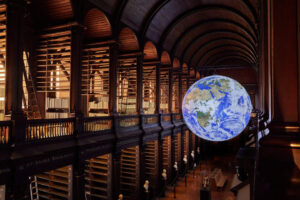 Visit Trinity College.
Visit Trinity College.
Trinity was founded in 1592 by Queen Elizabeth 1st on grounds confiscated from an Augustinian priory and is the oldest University in Ireland. The Campanile, erected in 1852, was built on what is believed to be the centre of the monastery. Built to further the education of the ruling Anglo-Irish families, restrictions were imposed to prevent Catholic from attending courses. These restrictions were not fully lifted until the 1970’s. Trinity however admitted women in 1902, earlier than most British universities. Most of the main buildings off the main square were built during the Georgian period, some of which replaced older buildings. 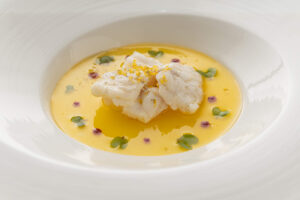
Within its walls, you will be able to admire Parliament Square and its 18th Century edifices. Trinity College has had many famous students such as Jonathan Swift and Samuel Beckett who later became a lecturer in French at the university. The Inter-denominational Church is very much worth a visit, should it be open during our visit. Check into your hotel
Overnight, bed & breakfast at your hotel in Dublin.
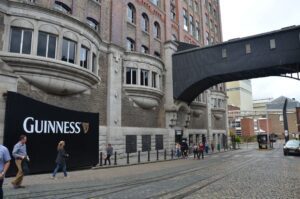 DAY -2/ DUBLIN CITY
DAY -2/ DUBLIN CITY
The Guinness Storehouse.
This morning visit the world famous Guinness Storehouse. The Guinness Brewery in Dublin is Europe's largest stout producing brewery and home to the Guinness Storehouse. Opened in 1904, the Storehouse was an operational plant for fermenting and storing Guinness. Today it houses a very fine exhibition dedicated to the Guinness story.
Visitors will discover what goes into the making a pint of Guinness - 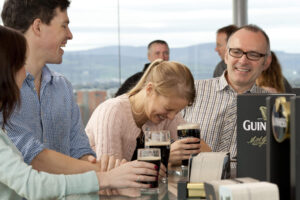 the ingredients, the brewing process, the time, the craft and the passion.
the ingredients, the brewing process, the time, the craft and the passion.
The exhibition shows how the brew has been marketed and how it is today sold in over 150 countries. Once the tour has finished, go up to the Gravity Bar to enjoy a fresh pint of Guinness. Regular demonstrations on the art of pulling a pint of Guinness also take place in the Storehouse. Launched on the fifth floor in 2011, "Five" at Guinness Storehouse, includes a small replica authentic Irish Bar, an 18th Century inspired Brewers Dining Hall, and a restaurant named Gilroy’s where guests enjoy a Guinness gastronomical 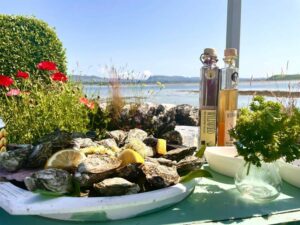 experience driven entirely by the Irish tradition of wholesome local produce.
experience driven entirely by the Irish tradition of wholesome local produce.
Menus include local foods such as Ardsallagh goat’s cheese, Irish mussels from Carlingford and the Waterford Blaas bread supplied by MD Bakery in Waterford.
This area will host from time to time live cooking demonstrations using Guinness in the recipe and it includes an interactive recipe sharing bank that allows visitors to take Guinness recipe cards home. Guinness Beef Stew,A hearty classic featuring tender beef, root vegetables, and a rich Guinness-infused broth.
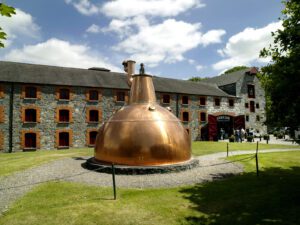 Visit to Old Jameson Distillery.
Visit to Old Jameson Distillery.
The Old Jameson Distillery in Smithfield Village is located in the heart of Old Dublin. This old barley storehouse, once the centre of Distilling in Dublin, was renovated in 1998 and converted into a museum where all the secrets of Irish whiskey’s distillation will be revealed.
An audio-visual show will introduce the history of this spirit and it is followed by a guided visit which will take you through the various stages of distilling from grain intake to malting, mashing, fermentation, distillation, maturation and finally bottling.
The visit culminates in the 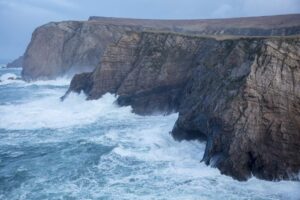 Jameson bar with an opportunity for all to taste the signature Jameson drink. During the visit a number of volunteers are selected to take part in a tasting session to compare a Jameson whiskey with a Scottish Whisky and American bourbon.
Jameson bar with an opportunity for all to taste the signature Jameson drink. During the visit a number of volunteers are selected to take part in a tasting session to compare a Jameson whiskey with a Scottish Whisky and American bourbon.
John Jameson & Son was founded in 1780 by John Jameson, a Scottish lawyer who established his distillery in Dublin, Ireland. The company quickly rose to prominence, becoming one of the world's leading whiskey producers by the early 19th century. Participants will receive a Diploma for their achievement.
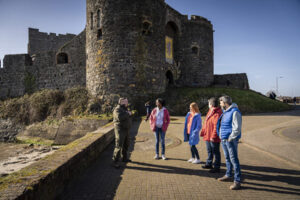 The Musical Pub Crawl.
The Musical Pub Crawl.
A great way to experience the Dublin pub scene and the rich heritage of Irish music is to venture on the Musical Pub-Crawl. Tours are led by professional musicians who will perform tunes and songs, while telling the story of Irish Music. The tours normally start in St John Gogarty’s Pub in Temple Bar. Lasting 2 hours approximately, you'll have plenty of time to enjoy the music while enjoying a drink (in each pub of course!). This evening join a session in Temple Bar.
Overnight, bed & breakfast at our hotel in Dublin
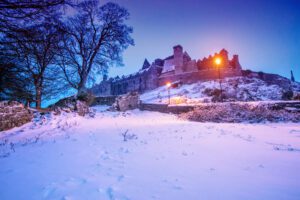 DAY -3/ DUBLIN TO KINSALE
DAY -3/ DUBLIN TO KINSALE
This morning depart Dublin for Co. Cork via Tipperary
Visit to Rock of Cashel.
Possibly the most photographed site in Ireland, the Rock of Cashel towers over the town of Cashel from its perch on a 200-foot high outcrop of limestone. Once the seat of the Kings of Munster. St. Patrick visited the rock in 450, while Brian Boru was crowned the first high King of Ireland here in the tenth century.  Granted to the church in the twelfth century, by the O'Brien clan, today the impressive stone walls enclose a round tower, a cathedral, a twelfth century Romanesque chapel and high crosses. The Vicars Choral has been recently restored and its basement houses a small museum of artefacts found on the site. One of the leading visitor attractions in Ireland, in 2011 it was visited by Queen Elizabeth II on her historic first visit to the Republic of Ireland. A guided tour is strongly recommended. Continue onto to Kinsale in Co. Cork, Check into our hotel. Spend an evening enjoying music in The Spaniard Inn.
Granted to the church in the twelfth century, by the O'Brien clan, today the impressive stone walls enclose a round tower, a cathedral, a twelfth century Romanesque chapel and high crosses. The Vicars Choral has been recently restored and its basement houses a small museum of artefacts found on the site. One of the leading visitor attractions in Ireland, in 2011 it was visited by Queen Elizabeth II on her historic first visit to the Republic of Ireland. A guided tour is strongly recommended. Continue onto to Kinsale in Co. Cork, Check into our hotel. Spend an evening enjoying music in The Spaniard Inn.
Overnight, bed & breakfast at our hotel in Kinsale.
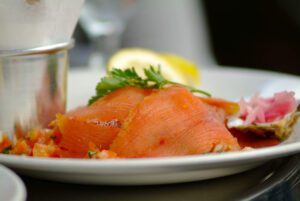 DAY -4/ KINSALE TO KENMARE
DAY -4/ KINSALE TO KENMARE
This morning, depart Kinsale for Kerry via Skibereen & Bantry in West Cork.
Visit to Bantry House & Gardens (please note this is only open April – October)
Bantry House is the ancestral home of the Earls of Bantry. The title lapsed in 1891 but the House is still owned and lived in by the direct descendant of the 1st Earl of Bantry, Egerton Shelswell-White and his family. It has been open to the public since 1946. 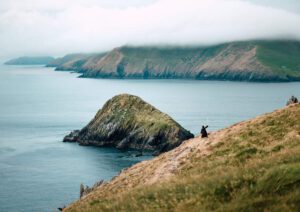 The House has an important collection of art treasures mainly collected by the 2nd Earl of Bantry on his Grand Tour. The treasures include a unique collection of French and Flemish tapestries, furniture, and carpets and objects of art.
The House has an important collection of art treasures mainly collected by the 2nd Earl of Bantry on his Grand Tour. The treasures include a unique collection of French and Flemish tapestries, furniture, and carpets and objects of art.
The Garden is laid out in the Italian style over seven terraces, with the house sitting on the third terrace. A Parterre was created facing south surrounding a wisteria circle which again surrounds a fountain.
From there rise the famous Hundred Steps, a monumental staircase built of local stone, set amidst azaleas and rhododendron. From the top garden at the top of the stairs, stunning views over Bantry Bay await the visitor. 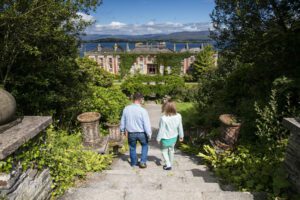
Bantry House hosts a number of events including classical and traditional music festivals, food festivals, outdoor theatre, and is a popular location for filming. A small cafe is open in the house during the season.
Continue along the Beara Pensinsula to Glengarriff and take a short ferry ride to Garnish Island.
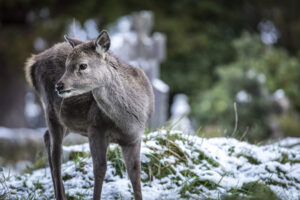 Visit to Garnish Island (Ferry & Garnish Island only running from April – October).
Visit to Garnish Island (Ferry & Garnish Island only running from April – October).
The Harbour Queen Ferries provides a regular service to the Gardens of Ilnacullin on Garnish Island. Ferries depart from Glengarriff Pier every 30 minutes during the season (April 1 – October 31). The ferries are purpose built enclosed water buses which will whisk you to the island in safety and comfort. Garinish is a unique Island that plays host to a multitude of plant variations, and the blanket of Summer colouring which covers the Island creates a rainbow of colour. The Island has a wonderful history and its unusual micro 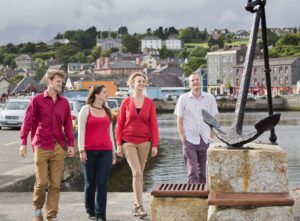 climate allows a range of exotic subtropical plant species to flourish.
climate allows a range of exotic subtropical plant species to flourish.
There are a number of walks and interesting buildings on the Island. On route to the Island you will enjoy the magnificent views of the bay and also pass Seal Island with its colony of harbour seals.
The seals are very photogenic and are happy to pose for photos! Continue on to Kenmare in County Kerry for an evening of entertainment.
Overnight, bed & breakfast at our hotel in Kenmare.
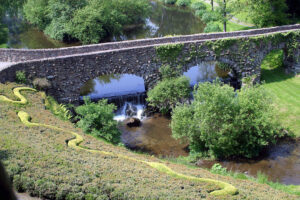 DAY -5/ KENMARE TO DINGLE
DAY -5/ KENMARE TO DINGLE
This morning explore the scenic area of Kenmare and
Visit to Star Outdoors for the Kenmare Bay Experience Cruise on Kenmare Bay.
See seals, castles and get history of salmon from hatching on Kenmare River to Ocean & back. (Duration approx. 45 minutes). Salmon Smokery Tour – Demonstration & including tasting (Duration max 30 minutes).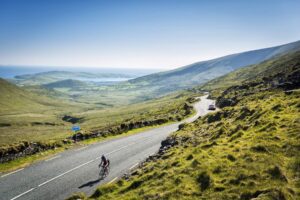 You can Lunch on a buffet of local Kenmare Bay fish products from mussels to white fish options, local meat products such as corned beef, black pudding etc, local cheeses, honey, brown bread.
You can Lunch on a buffet of local Kenmare Bay fish products from mussels to white fish options, local meat products such as corned beef, black pudding etc, local cheeses, honey, brown bread.
Depart Kenmare for Dingle Peninsula via Ring of Kerry. Enjoy a stop at two of the Ring of Kerry’s most spectacular beauty spots.
Molls Gap and Ladies’ View- Molls’ Gap is a spectacular photographic viewing point on the famous Ring of Kerry Tour. The visitor is presented with a magnificent view of Death Valley.
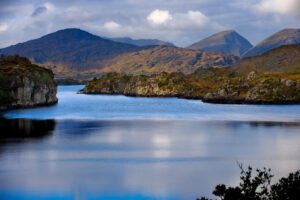 The Lakes Of Killarney
The Lakes Of Killarney
Close by is the famous Ladies View viewing point which gives a different perspective of this magnificent countryside, with the 3 Lakes of Killarney all surrounded by the Kerry Mountains. Ladies View is a renowned scenic viewpoint located approximately 12 miles (19 km) from Killarney on the N71 road to Kenmare, within the picturesque Killarney National Park.
Ladies View received its name from Queen Victoria, who was so impressed with the view that she insisted that her ladies-in-waiting should also visit here.
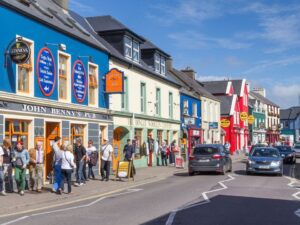 Continue onto Dingle Peninsula for lunch at one of the many great Restaurants in town or on Inch Beach - a long beach bordered by dunes and made famous by David Lean’s movie “Ryan’s daughter,” admire the Iveragh Peninsula and Rossbeigh Beach.
Continue onto Dingle Peninsula for lunch at one of the many great Restaurants in town or on Inch Beach - a long beach bordered by dunes and made famous by David Lean’s movie “Ryan’s daughter,” admire the Iveragh Peninsula and Rossbeigh Beach.
This afternoon explore the Dingle Peninsula. Some of the finest coastal scenery to be seen in Ireland can be found in West Kerry, on the Dingle Peninsula, the most northern of the Kerry Peninsulas. This peninsula is famous for its Celtic, pre-Christian monuments and Christian churches. It is also a ‘Gaeltacht' (Irish speaking) area, where the Irish language and traditional ways of life are preserved.
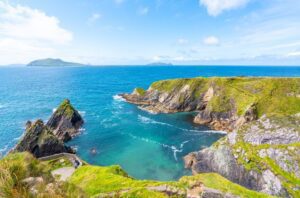 Dingle town itself is a thriving fishing town and offers plenty of opportunity for shopping or simply savouring the atmosphere of a typical country Irish town with its plentiful pubs, narrow streets and busy harbour.
Dingle town itself is a thriving fishing town and offers plenty of opportunity for shopping or simply savouring the atmosphere of a typical country Irish town with its plentiful pubs, narrow streets and busy harbour.
The road around the Peninsula is truly spectacular. It passes through a chain of Mountains, called Slieve Mish... Enjoy an evening of Irish Music & entertainment in Dingle.
Overnight, bed & breakfast at our hotel in Dingle
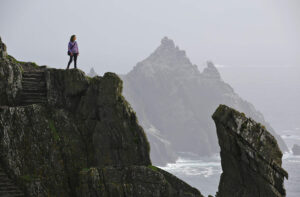 DAY -6/ THE DINGLE PENINSULA
DAY -6/ THE DINGLE PENINSULA
Explore the Dingle Peninsula starting with Slea Head - From Dingle, drive around the coast to Slea Head. Here the blue of the marine landscape surrounds the Blaskets Islands, deserted since 1953. In the distance are the two rocky Skellig islands, where the ruins of an early Christian Monastery can be found.The Dingle Peninsula will charm you with its villages painted in bright colours and will bewitch you with the dramatic beauty of its landscapes.
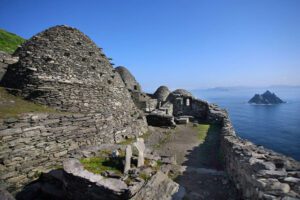 Beehive Huts & Dunbeg Fort & Slea Head.
Beehive Huts & Dunbeg Fort & Slea Head.
The road between Dunquin and Slea Head is dotted with beehive huts, forts and church sites. Prehistoric Dunbeg Fort is on a cliff top promontory with a sheer drop to the Atlantic and has four outer walls of stone. Inside are the remains of a house and a beehive hut as well as an underground passage. Beehive huts are circular stone buildings shaped like a beehive which was lived in by the Kerry monks. Continue around the peninsula exploring some of Ireland’s nicest & picturesque local shops, pubs, cafes etc. Overnight, bed & breakfast at our hotel in Dingle
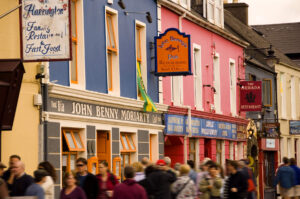 DAY -7/ DINGLE TO ENNIS
DAY -7/ DINGLE TO ENNIS
Today you will depart Kerry towards County Clare. En route to Clare, stop in Limerick for a visit and Irish coffee at Foynes Flying Boat Museum.
Foynes Flying Boat Museum.
From 1939 to 1945 Foynes was the centre of the aviation world for air traffic between the United States and Europe. Located 35 km west of Limerick city on the Shannon estuary, the Foynes Museum recalls this era with a comprehensive range of exhibits and graphic illustrations. 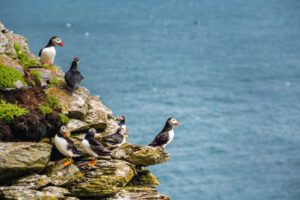 The museum features the original Terminal Building including the authentic 1940's cinema; the Radio and Weather Rooms, complete with transmitters, receivers and Morse code equipment.
The museum features the original Terminal Building including the authentic 1940's cinema; the Radio and Weather Rooms, complete with transmitters, receivers and Morse code equipment.
The exhibits feature an introduction to the first transatlantic passenger service from Foynes during the war years and the only full sized replica B314 flying boat.Irish Coffee was invented in Foynes. Chef Joe Sheridan made the first in 1942 to warm up some damp and miserable passengers. Since then Irish Coffee has become one the most popular welcoming drinks in the world. Continue to Bunratty Castle & Folk Park.
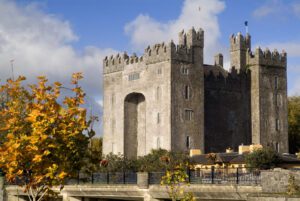 Bunratty Castle & Folk Park.
Bunratty Castle & Folk Park.
Bunratty Castle is one of the most complete and authentic medieval castles in Ireland. Built in 1425 and plundered on many occasions, it was authentically restored in 1954 to its former medieval splendour and now contains mainly 15th and 16th century furnishings and tapestries capturing the mood and the style of the times.
The castle hosts evening medieval banquets and takes the participants back to the time that the castle entertained its visitors with fine food, wine and song.
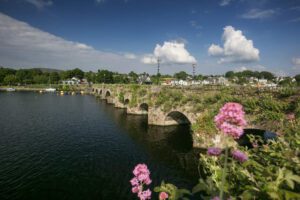 Within the grounds of Bunratty Castle is Bunratty Folk Park where 19th century life is vividly recreated. Set on 26 acres, the impressive park features over 30 buildings in a ‘living’ village and rural setting. Meet and chat with the Bean an Ti and various street characters including the Policeman and Schoolteacher. Enjoy the tastes, scents, sights and sounds of this enchanting place as you stroll from house to house or around the charming village complete with school, post office, doctors house, hardware shop, printers and of course the pub! Music in local pub in Ennis.
Within the grounds of Bunratty Castle is Bunratty Folk Park where 19th century life is vividly recreated. Set on 26 acres, the impressive park features over 30 buildings in a ‘living’ village and rural setting. Meet and chat with the Bean an Ti and various street characters including the Policeman and Schoolteacher. Enjoy the tastes, scents, sights and sounds of this enchanting place as you stroll from house to house or around the charming village complete with school, post office, doctors house, hardware shop, printers and of course the pub! Music in local pub in Ennis.
Overnight, bed & breakfast at our hotel in Ennis.
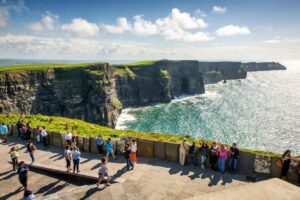 DAY -8/ ENNIS TO GALWAY
DAY -8/ ENNIS TO GALWAY
The Cliffs Of Moher
Situated on the Atlantic Ocean and bordering the Burren Area, the Cliffs of Moher are one of Ireland's most spectacular sights. Standing 230 metres above the ground at their highest point and 8km long, the Cliffs boast one of the most amazing views in Ireland. On a clear day, the Aran Islands are visible in Galway Bay as well as the valleys and hills of Connemara. To the south of the cliffs is Hag's Head.
The cliffs reach their highest point just north of O' Brien's Tower. 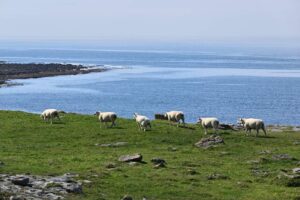 Cornelius O’ Brien, a descendant of Brian Boru (he who defeated the Vikings in battle), built a Tower at the cliffs in order to enjoy some tea with his lady friends.
Cornelius O’ Brien, a descendant of Brian Boru (he who defeated the Vikings in battle), built a Tower at the cliffs in order to enjoy some tea with his lady friends.
The Tower is adjacent to the sea stack, Breanan Mór, which stands over 70 metres above the foaming waves and is home to some of the Burren’s wildlife.
Continue onto Doolin for lunch and a session.
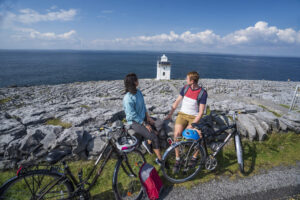 Doolin & The Burren
Doolin & The Burren
Doolin is a charming small seaside village on the north-west coast of County Clare ~ set against the rugged Atlantic Ocean and surrounded by the spectacular bare limestone landscape of the Burren. Traditionally a fishing village, Doolin is now renowned world-wide as the traditional music capital of Ireland.
The Burren, part of which forms the 100 square km Burren National Park, is a unique place. It is a Karst limestone region of approximately 300 sq. km, which lies in the North West corner of Co Clare. It is composed of limestone pavements, which have been eroded to a distinctive pattern. 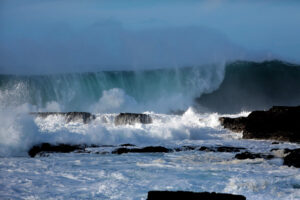 This pavement is criss-crossed by cracks known as grykes in which grow a myriad of wild flora and under which are huge caves and rivers which suddenly flood when it rains.
This pavement is criss-crossed by cracks known as grykes in which grow a myriad of wild flora and under which are huge caves and rivers which suddenly flood when it rains.
The Burren contains dozens of megalithic tombs and Celtic crosses as well as a ruined Cistercian Abbey dating back to the 12th century. You will discover small villages abandoned during the famine period and green roads on which you can walk for miles without ever seeing a car. The flora on the Burren is a mixture Arctic and Mediterranean and rare flowers such as gentian, 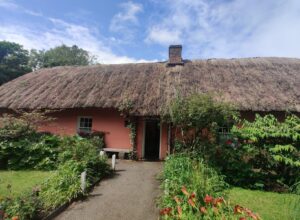 orchids and bloody cranesbill are the rule rather than the exception. The Burren is truly an exceptional part of Ireland. Continue onto Galway for an evening of music in a local pub.
orchids and bloody cranesbill are the rule rather than the exception. The Burren is truly an exceptional part of Ireland. Continue onto Galway for an evening of music in a local pub.
Tig Cóilí (pronounced "Tig Co-lee") is a beloved traditional Irish pub nestled in the heart of Galway's Latin Quarter, specifically on Mainguard Street, just off the bustling Shop Street.It is renowned for its authentic atmosphere and lively traditional Irish music sessions, it's a must-visit for both locals and tourists seeking a genuine Irish pub experience.
Overnight, bed & breakfast at our hotel in Galway.
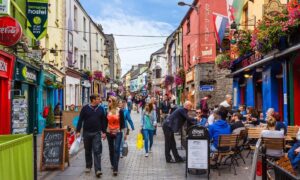 DAY -9/ GALWAY TO WESTPORT
DAY -9/ GALWAY TO WESTPORT
Connemara
Connemara is a land of lakes and rivers, bogs and mountains. A land of small villages where Gaelic is still the spoken language and where little has changed little since the beginning of time. It is without a doubt the wildest and the most romantic part of Ireland. Connemara is a vast peninsula bordered by the arid and rocky coastline of Galway Bay in the south ~ a land characteristic for its stone walls and thatched cottages. 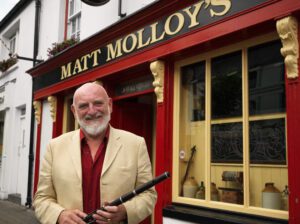
On its northern shore the land is harsher and more secret, with spectacular views of the Ocean and the beautiful fjord of Killary Harbour, as well as the steep mountains overlooking numerous lakes and large bog areas.
Part of the Wild Atlantic Way, Connemara is a rugged and enchanting region in County Galway, Ireland, renowned for its untamed landscapes, Gaelic heritage, and rich cultural tapestry. Connemara is a real paradise for Nature lovers and those in search of strong emotions.
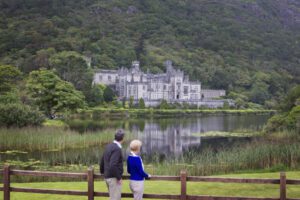 Visit to Kylemore Abbey
Visit to Kylemore Abbey
Kylemore Abbey is located in the Kylemore Pass in Connemara. A. Mitchell Henry built the House in 1868, after having spent his honeymoon in the area. The architecture is best described as neo-gothic and the house still displays all the characteristics of that period. One of Kylemore Abbey's most famous features is its miniature cathedral, built in 1870 and known locally as the Gothic church. Today, the abbey is home to the Irish order of Benedictine nuns. They bought the house in 1920, having fled their convent in war-torn Belgium in 1914. They established a private school for young girls, which today is the renowned Kylemore Abbey International School for young girls. 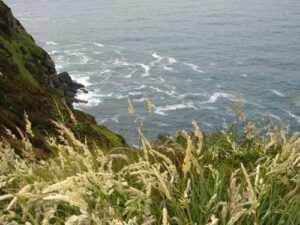
Facilities at Kylemore include a visitor centre, an exhibition housed in the main reception rooms of the house and a video which takes the visitor through the history of the house and its occupants.
This afternoon depart Connemara towards Westport in County Mayo, through the coastal town of Clifden. Enjoy and evening of Music in Matt Molloy’s pub in Westport!
Overnight, bed & breakfast at our hotel in Westport.
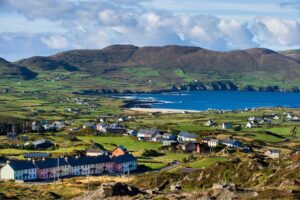 DAY -10/ WESTPORT TO DUBLIN
DAY -10/ WESTPORT TO DUBLIN
Today, depart Westport for Dublin via County Roscommon and visit Strokestown Park & Famine Museum.
Strokestown Park & Famine Museum.
Strokestown Park was built by Thomas Mahon MP (1701-1782) on lands which had been granted to his grandfather, Nicholas, in the latter half of the 17th century for his support in the British colonial campaign.
 It was the family home of the Mahon family until 1979. The house provides a fascinating glimpse into the Anglo-Irish ascendancy. Many rooms are on show including a schoolroom and a child’s bedroom, complete with 19th century toys and mirrors. The Famine Museum is located in the original Stable Yards of Strokestown Park House. It was designed to commemorate the history of The Great Irish Famine of the 1840's and in some way to balance the history of the 'Big House'. Whereas the landlord class had the resources to leave an indelible mark on the landscape, the Irish tenants lived in poverty and nothing of a physical nature has survived to commemorate their lives.
It was the family home of the Mahon family until 1979. The house provides a fascinating glimpse into the Anglo-Irish ascendancy. Many rooms are on show including a schoolroom and a child’s bedroom, complete with 19th century toys and mirrors. The Famine Museum is located in the original Stable Yards of Strokestown Park House. It was designed to commemorate the history of The Great Irish Famine of the 1840's and in some way to balance the history of the 'Big House'. Whereas the landlord class had the resources to leave an indelible mark on the landscape, the Irish tenants lived in poverty and nothing of a physical nature has survived to commemorate their lives. 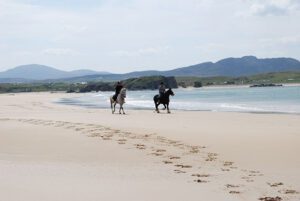 Continue to Dublin to enjoy an evening of music at a local pub.
Continue to Dublin to enjoy an evening of music at a local pub.
Overnight, bed & full Irish Breakfast at our hotel in Dublin.
DAY -11/ FAREWELL
After a final full Irish breakfast depart for Dublin Airport for your departure flight home.
About this trip
Traveling from Dublin City to Kinsale via the Rock of Cashel is a scenic and culturally rich route. Explore medieval ruins at the Rock of Cashel where you will see the seat of the once named Kings of Munster.
St. Patrick visited the rock in 450, while Brian Boru was crowned the first high King of Ireland here in the tenth century.
Traveling from Kenmare to Garnish Island (also known as Ilnacullin) offers a delightful journey through some of Ireland's most picturesque landscapes, culminating in a visit to this unique island.
See The Dingle Peninsula, Beehive Huts, The Lakes of Killarney and Bunratty Castle, Marvel at the Natural beauty of The Cliffs of Moher and much more awaits you on this 11-Day tour in Ireland!
Why Choose this Tour
**Experience Dublin City
**Enjoy the stunning Southwest of the Island
**Flexibility to wander wherever you wish during your visit
**Visit Ireland's most famous bucket list destinations
**Stress-Free Planning – All the details are handled, so you can relax and fully enjoy the experience
Additional Info
Services:
*10 nights’ accommodation at good standard 3/4* hotels, all rooms with private bath or shower
*Full Irish Breakfast at hotel each day, day 2 – 11 inclusive
*Service charges and taxes at existing rates
Hotels or Similar:
4* The Gresham Hotel, Dublin - 3 Nights
4* The Trident Hotel, Kinsale - 1 Night
3* Kenmare Bay Hotel, Kenmare - 1 Night
4* Benners Hotel, Dingle - 2 Nights
4* Old Ground Hotel - Ennis - 1 Night
4* Meyrick Hotel, Galway - 1 Night
4* Westport Plaza Hotel - 1 Night


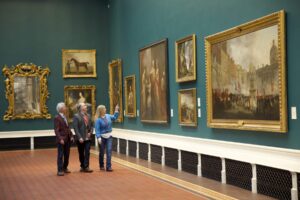
 Call Benny
Call Benny